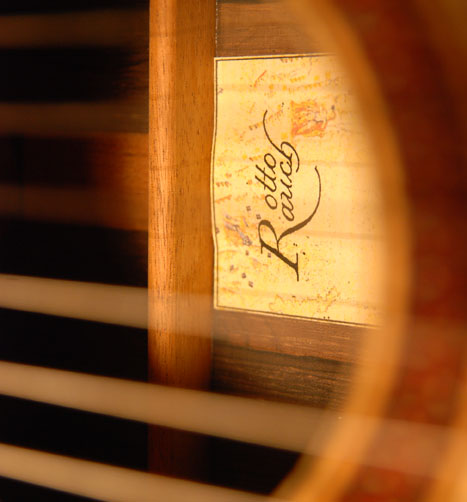
|



In the course of time, I have studied and worked with different
guitar forms.
The idea of limiting myself to only one guitar model seemed too one-sided
to me.
A guitar’s size and its contours have a considerable effect on the
sound of the guitar. My somewhat smaller classical guitar was developed
in the style of a Hauser I guitar from 1930. It is not a copy of the Hauser
guitar, however. The original guitar was played by Andres Segovia; in
1973 the British luthier José Romanillos built a similar one for
Julian Bream. Small guitar, “small sound”?
Not at all! More like a wild mustang!
 |
|

Concert guitars
Different designs:
• Solid top
• Double top
• Hauser model
• Torres model
• Estudio models
• Scale length available on request
Prices available on request

|
    
The appeal of my Hauser model lies in its enormous volume –
a focused and resonant sound with a strong bass range. The distinct
middle range enhances this instrument’s brilliant highs with
a great deal of warmth. This model is also well-suited for smaller
scale lengths.
The Antonio Torres model from 1885 is somewhat larger than the Hauser
model in terms of contours. Its characteristics are similar, but
it has a somewhat deeper sound.
The largest model among my modern classical guitars is the Otto
Rauch model.
I also prefer to use this model for my double-top guitars to give
them a mellowness and depth of character.
|

|
 |
|
Biedermaier guitars
Johann Anton Stauffer,
• Terz guitar
• Vienna, about 1830
• "Luigi Legnani model"
• Scale length: 55.9 cm
Franz Schmidt
• Prime guitar
• Vienna, about 1830
• Scale length: 59.7 cm
Prices available on request
|
  

|
 |
|
Baroque guitars
Antonio Stradivari, 1688 and 1700
• Scale length: 63cm (or as desired)
• Top made of spruce wood
• Ribs made of maple
• Tuning: E' BB GG D'D A'A
Prices available on request |
  
|
For those of my instruments which are also made with Brazilian rosewood,
I apply for a certificate from the National Conservation Authority. The
“CITES” form is then the instrument’s identification
document. It authorizes you to own the Brazilian rosewood, which is under
species protection, in the guitar and allows you and your instrument to
visit all foreign countries without any border or customs problems! |
|
|











